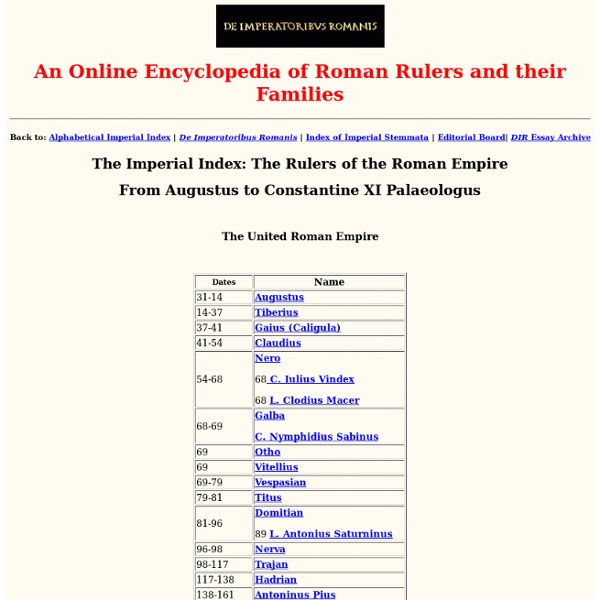



Empereur romain germanique Un article de Wikipédia, l'encyclopédie libre. L’empereur romain germanique est le vocable sous lequel est désigné le souverain du Saint-Empire. Le titre officiel d’empereur des Romains étant contesté par les empereurs byzantins, l’historiographie a consacré l’usage du terme d’empereur romain germanique. Il était élu par le collège des princes-électeurs. Selon les usages de la chancellerie impériale, notamment sous Charles Quint, la titulature complète en était « par la divine clémence, empereur des Romains toujours auguste », « divina favente clementia Romanorum imperator semper augustus » en latin. Entre le moment de son élection et son couronnement, ce prince était titré roi des Romains. Roman Emperors Empereurs romains - Jules Cesar (Caius Julius Caesar) Enfin rentré à Rome, il entreprit sa marche vers le pouvoir absolu auquel il allait être porté par le consentement (résigné) du peuple. Il fut sans doute impliqué, mais ce rôle reste assez obscur, dans la conjuration de Catilina, (-63). À cette occasion, il s'opposa aux mesures radicales (et illégales) d'un Cicéron par ailleurs fort suspect d'avoir monté en épingle ce minable complot populiste pour se poser en "Sauveur de la République" et en "Père de la Patrie". Préteur en -62, propréteur d'Espagne en -61, Jules forma ensuite un Triumvirat avec Pompée et Crassus. L'autorité de Rome, limitée, à cette époque, à une simple bande littorale entre Monaco et Narbonne, allait, grâce au "Génie de César", s'étendre désormais à l'intérieur des terres gauloises. Au nord de la Gaule, les Belges se révoltèrent. Mais de tout ce folklore celtique, César n'en avait rien à cirer ! Quelques jours plus tard, César arrivait à son tour à Alexandrie d'Égypte. … Pour peu de temps !
Histoire romaine (Dion Cassius)/Livre XLII Tel fut donc cette bataille. Et Pompée désespéra aussitôt de tous ses projets, et il ne tint plus aucun compte de sa propre valeur, ni de la multitude des troupes qui lui restaient, ni du fait que la fortune change souvent après un laps de temps ; alors qu’auparavant il était toujours d’un caractère fort jovial et d’un optimisme à toute épreuve. La raison en était qu’en ces occasions il se trouvait habituellement sur un pied d’égalité avec son ennemi et que par conséquent il ne considérait pas la victoire comme allant de soi ; il supputait les deux issues possibles des événements quand il était encore calme et qu’il n’était pas encore rempli d’inquiétude ; il se préparait au pire. Ainsi il n’était pas forcé de céder aux désastres et pouvait facilement reprendre le combat ; mais cette fois, comme il avait voulu prouver qu’il vraiment supérieur à César, il n’avait pris aucune précaution. Peu après Octavius les rejoignit également. Voilà ce qui se passait à l’étranger.
Histoire romaine - Théodore Mommsen Sortons enfin des sphères étroites et monotones de l’égoïsme politique, qui n’a mené ses combats que dans ou dans les rues de la capitale. L’histoire, dans sa marche, nous conduit vers un monde où s’agitent d’autres et plus importantes questions que celle de savoir si le premier monarque de Rome s’appellera Gnæus, Gaius ou Marcus. Il nous sera permis sans doute, au seuil d’événements. dont les conséquences pèsent encore sur les destinées du monde, de jeter autour de nous les -yeux, et de retracer, comme en un tableau d’ensemble, les éléments et les rapports au milieu desquels se placent la conquête par les Romains du territoire de actuelle, et leurs premiers contacts avec les habitants de, l’Allemagne et de . Déjà, pour être juste, il faut ranger parmi les entreprises tendant à la soumission de l’Occident, la campagne de César dans l’Espagne ultérieure, en l’an 693 [ ] . Tout autre était le tableau, dès que l’on avait franchi la frontière romaine.